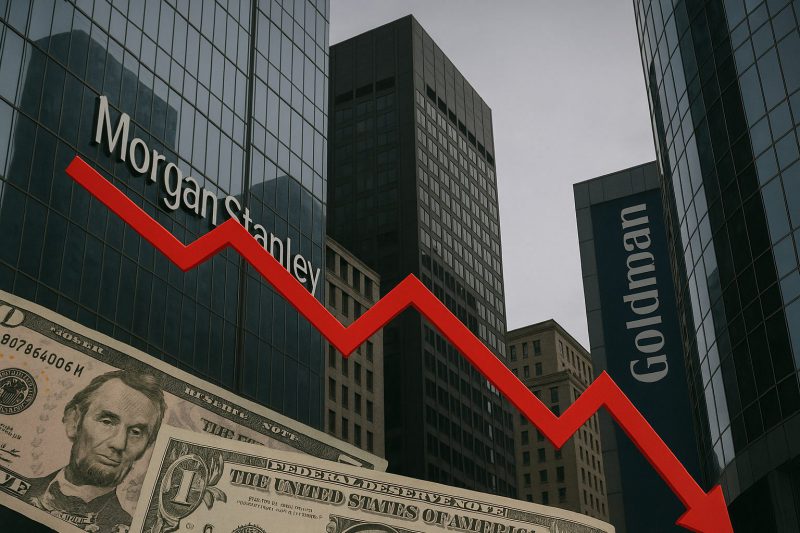Major Wall Street banks are now predicting that de-dollarization trends will continue accelerating, and they’re forecasting further weakness in the US dollar ahead. Right now, Morgan Stanley, JPMorgan Chase, and Goldman Sachs are all reinforcing their bearish calls on the greenback, citing interest-rate cuts, slowing economic growth, and President Trump’s trade policies as the main drivers.
This global de-dollarization trend is gaining momentum as investors become increasingly concerned about currency diversification risks, and Wall Street’s dollar forecast models are pointing to significant declines ahead.
Also Read: De-Dollarization: Full List of Countries Dropping the US Dollar & Key Reasons
Wall Street’s De-Dollarization Fears Point To Global Currency Risks


Major Banks Signal Dollar Weakness
Wall Street institutions are becoming more vocal about their concerns regarding de-dollarization, and Morgan Stanley has made headlines by predicting that the dollar will tumble to levels last seen during the COVID-19 pandemic by the middle of next year. The bank is forecasting that the US Dollar Index will fall about 9% to hit 91, which represents a significant decline from current levels. At the time of writing, JPMorgan Chase also remains bearish on the US currency, and their strategists are now recommending bets on the yen, euro, and Australian dollar instead.
The concerns about this global de-dollarization trend became more apparent on Monday when the dollar fell against all its peers in the Group of 10. Skylar Montgomery Koning, a currency strategist at Barclays Plc, had this to say:
“Headwinds for the dollar could come in the form of further bond market weakness, an escalation in the trade war, softer US data.”
Goldman Sachs has also added another layer of concern, suggesting that Washington’s efforts to explore alternative revenue sources may be even more negative for the dollar than initially anticipated. The Wall Street dollar forecast consensus is becoming increasingly pessimistic as more data points to continued weakness.
Policy Impact Drives Currency Rethink


Trump’s trade policies are denting sentiment on US assets, and this is triggering a broader rethink about the world’s reliance on the greenback. The currency diversification risks are becoming more apparent to investors, and many are starting to question their heavy exposure to dollar-denominated assets.
Right now, the bearishness hasn’t reached extreme levels, which actually suggests there’s potential for more dollar weakness ahead, according to Commodity Futures Trading Commission data. Morgan Stanley strategists, including Matthew Hornbach, stated:
“We think rates and currency markets have embarked on sizable trends that will be sustained– taking the US dollar much lower and yield curves much steeper — after two years of swing trading within wide ranges.”
Investment Risks And Currency Winners


Potential policy changes that could affect foreign investment in US assets are also driving the concerns about de-dollarization on Wall Street. Goldman Sachs strategists are particularly focusing on potential changes to US tax rates on foreign individuals and companies, and these measures could create significant implications for dollar demand.
Goldman Sachs strategists, including Kamakshya Trivedi and Michael Cahill, stated:
“Even if the application is relatively narrow, such a tool would exacerbate concerns about risks of US investments, at a time when investors are already looking at shifting cross-asset correlations as a reason to seek greater diversification away from U.S. assets.”
In a separate report, Goldman Sachs noted that their models suggest the dollar is about 15% overvalued, which means it has further to fall. Reallocation and repricing of global assets will likely drive the expected decline, and this supports the broader Wall Street dollar forecast for continued weakness.
Morgan Stanley sees the euro rising to around $1.25 next year from current levels of $1.1450, and they also expect the yen to strengthen to 130. The Federal Reserve is expected to deliver 175 basis points of interest-rate cuts, which will further reduce the dollar’s appeal to international investors.
Also Read: Standard Chartered: De-Dollarization Overblown, Dollar Down 10% by 2026
The growing consensus around de-dollarization among Wall Street’s major players reflects deeper concerns about the global de-dollarization trend and the currency diversification risks that investors are facing. Right now, investors are looking to upcoming US labor market indicators for guidance on Fed policy shifts and their implications for the dollar’s future trajectory.





